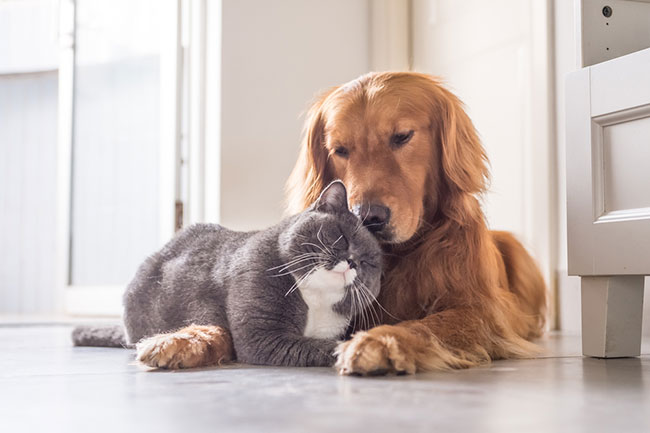
British Shorthairs, a breed celebrated for their majestic and plush appearance, embody a temperament that is as appealing as their looks. Darina, an expert on British Shorthairs and the owner of Meowoff, highlights that these cats are the epitome of a calm and composed demeanor. They are known for their undemanding and affectionate nature, making them perfect companions for a wide range of households. Unlike some breeds that constantly seek attention, British Shorthairs offer a balanced blend of independence and affection.
Their adaptability is one of their most remarkable traits. Whether in a bustling family environment or a quiet single-person home, they adjust with ease, showcasing their versatile nature. This adaptability extends to their interactions with other pets, including dogs, making them suitable for multi-pet households. Their non-confrontational approach often means they are less likely to engage in aggressive behavior, a significant advantage for those looking to introduce a dog into the family.
Understanding the true nature of British Shorthairs is essential for pet owners. Recognizing their need for a peaceful environment, their affectionate yet independent disposition, and their ability to adapt to various situations can greatly aid in creating a harmonious multi-pet household.
Common Misconceptions
Despite their seemingly stoic appearance, British Shorthairs are far from being unemotional or distant. A common misconception is that they are aloof and indifferent to human interaction. In reality, they often form strong bonds with their owners and seek out their company, albeit in a less demanding manner than some other breeds. They may not constantly seek out lap time or demand attention, but they do appreciate affection and companionship.
Another misconception is that British Shorthairs are always sedentary and inactive. While they are not as hyperactive as some breeds, they do enjoy playtime and can be quite curious and playful, especially in their younger years. Providing them with stimulating toys and interactive play sessions can help keep them active and engaged.
Understanding the true nature of British Shorthairs is crucial for pet owners, especially those considering introducing a dog into the family. Recognizing their need for a peaceful environment, their affectionate yet independent nature, and their ability to adapt to various situations can greatly aid in creating a harmonious multi-pet household.
The Dynamics of Dogs with Cats
General Dog Behavior Towards Cats
The interaction between dogs and cats can range from harmonious to challenging, largely influenced by the dog’s breed, personality, and upbringing. Typically, dogs have a natural instinct to chase smaller animals, which can include cats. However, this doesn’t necessarily mean aggression; often, it’s a play behavior or a manifestation of their prey drive. Understanding and managing this instinct is crucial in a household with both dogs and cats.
Socialization plays a key role in how dogs perceive and interact with cats. Dogs that have been exposed to cats from a young age are more likely to be calm and non-aggressive around them. On the other hand, dogs with limited exposure to cats may exhibit curiosity, excitement, or even aggression when first encountering a feline companion. It’s important for pet owners to recognize these behaviors and intervene appropriately to ensure a safe and positive interaction.
Breed-Specific Considerations
Breed characteristics can significantly influence how a dog interacts with cats. Some breeds, like Golden Retrievers, Beagles, and Boxers, are known for their friendly and sociable nature, often making them more compatible with cats. These breeds typically exhibit lower prey drives and a more easygoing temperament, making the introduction and cohabitation process smoother.
Conversely, breeds with a high prey drive, such as Greyhounds, Terriers, and Huskies, may require more careful management and training to coexist peacefully with cats. These breeds have a natural inclination to chase and hunt, which can be triggered by a cat’s movement. However, with proper training and socialization, even high-prey-drive dogs can learn to live harmoniously with cats.
Mixed-breed dogs can exhibit a range of behaviors inherited from their parent breeds. It’s important to observe and understand the individual dog’s personality and tendencies, regardless of breed, when introducing them to a cat.
In addition to breed, the individual dog’s history and experiences play a significant role. A dog that has had negative experiences with cats in the past may be more challenging to introduce to a feline companion. Similarly, a dog that has lived peacefully with cats before is likely to do so again.
In summary, understanding the general behavior of dogs towards cats, along with considering breed-specific traits and individual histories, is essential for creating a successful multi-pet household. This knowledge helps in preparing for and managing the interactions between these two distinct species, paving the way for a peaceful coexistence.
Preparing for a Multi-Pet Household
Essential Preparations Before Introduction
Creating a harmonious multi-pet household starts with thoughtful preparation before the actual introduction of a British Shorthair cat to a dog. The first step is ensuring that both pets are in good health. A visit to the vet for a check-up is advisable to rule out any health issues that could affect their behavior. Vaccinations should be up-to-date to prevent any potential transmission of diseases.
It’s also important to consider the temperament and past experiences of each pet. If either the dog or the cat has had negative experiences with the other species in the past, extra care and slow introduction are necessary. For pets with no prior experience, curiosity will likely be the initial response, which needs to be monitored and guided.
Acclimating the pets to each other’s scent can greatly aid in the introduction process. This can be done by exchanging bedding or toys between the cat and the dog, allowing them to get used to each other’s smell before meeting face-to-face. This scent swapping helps in establishing a sense of familiarity, reducing potential fear or aggression during the first meeting.
Creating a Safe Space for Both Pets
Designating safe, separate spaces for each pet is crucial. For the British Shorthair, this could mean having a cat tree or a high shelf where they can retreat to and observe from a distance, feeling secure in their own territory. For the dog, a specific bed or crate where they can relax and feel at home is important. These personal spaces should be respected by all family members, including the other pet.
Introducing feeding stations and litter boxes in locations where the cat feels safe and the dog cannot intrude is also important. Cats should have easy access to their litter box without having to pass closely by the dog, reducing stress and potential conflicts.
Environmental enrichment is key to a successful multi-pet household. This includes having toys, scratching posts for the cat, and chew toys for the dog. Such items not only keep the pets entertained but also help in reducing potential destructive behavior due to boredom or stress.
In addition to physical preparations, it’s also important to prepare mentally and emotionally for the introduction. Patience and understanding are crucial, as each pet will adjust at their own pace. Being prepared for setbacks and being willing to adjust strategies as needed are part of the process in creating a peaceful multi-pet household.
Introducing British Shorthairs to Dogs
Step-by-Step Introduction Process
Introducing a British Shorthair to a dog requires a careful and gradual approach to ensure a positive experience for both pets. The process should ideally be spread over several days or even weeks, depending on the animals’ reactions to each other.
- Initial Separation: Start by keeping the British Shorthair and the dog in separate rooms. This allows them to get used to the presence and scent of the other without direct contact. During this phase, continue the scent swapping by exchanging bedding or toys.
- Controlled Visual Contact: Once both animals seem comfortable with the scent, introduce visual contact. This can be done by using a baby gate or a door left slightly ajar. It’s important to monitor their reactions and continue this step until both pets appear relaxed and show no signs of aggression or excessive fear.
- Supervised Face-to-Face Introduction: The next step is a controlled face-to-face meeting. Keep the dog on a leash and allow the cat to roam freely. This ensures that the cat can retreat if it feels threatened. Keep these sessions short and positive, gradually increasing the time as they become more comfortable with each other.
- Allowing Interaction: As they show signs of acceptance, allow them to interact more freely under supervision. Ensure that escape routes are available for the cat. Continue to use positive reinforcement, such as treats and praise, to encourage calm and friendly behavior.
Reading Pet Body Language
Understanding and interpreting the body language of both the British Shorthair and the dog is essential. Look for signs of stress or aggression:
- For cats: Hissing, arching the back, flattening ears, and puffing up fur.
- For dogs: Growling, stiff body posture, fixating on the cat, or excessive barking.
Positive signs include relaxed body posture, playful behavior, and a general lack of focus on the other animal. If any signs of stress or aggression are observed, separate the pets and slow down the process.
Troubleshooting Common Issues
- Fearfulness: If either pet seems overly fearful, give them more time to adjust before proceeding with further introductions. Never force interactions.
- Aggression: In case of aggression, immediately separate the pets and consult a professional behaviorist. They may need a more structured introduction process.
- Overexcitement: If the dog is too excited, additional training and exercise might be needed to help them calm down before meeting the cat.
- Jealousy: Provide equal attention to both pets to avoid jealousy. This includes separate but equal playtime and affection.
Remember, patience is key in this process. Some pets may take longer to adjust to each other, and that’s perfectly normal. The goal is to ensure a safe and stress-free environment for both the British Shorthair and the dog, leading to a harmonious coexistence.
Maintaining Long-Term Harmony
Daily Routines for Coexistence
Establishing and maintaining a structured daily routine is crucial for long-term harmony between a British Shorthair and a dog. Consistency in their daily activities helps both pets understand what to expect, reducing anxiety and potential conflicts.
- Feeding: Feed the pets at the same time but in separate spaces to prevent food aggression or competition. This also reinforces the idea that they can enjoy their meals without feeling threatened by the other’s presence.
- Playtime: Allocate individual playtime for each pet to ensure they both get adequate attention and exercise. Additionally, engage in activities that both pets can participate in, like interactive toys, to encourage positive interactions.
- Resting Areas: Ensure that each pet has its own designated resting area where they can relax undisturbed. This is especially important for the British Shorthair, as cats often need a quiet and secure place to retreat.
- Training: Continue training the dog to obey commands, especially those that help manage their behavior around the cat, such as ‘sit’, ‘stay’, and ‘leave it’. Positive reinforcement techniques work best.
- Monitoring Interactions: Regularly observe the interactions between your British Shorthair and the dog. Look for signs of stress or discomfort and intervene if necessary. Over time, these observations can help you understand their relationship dynamics better.
When to Seek Professional Help
Despite best efforts, there might be situations where professional help is needed:
- Persistent Aggression or Fear: If either pet shows continuous signs of aggression or fear towards the other, it might be time to consult a pet behaviorist. They can provide tailored strategies and interventions.
- Behavioral Changes: Sudden changes in behavior, such as increased hiding, aggression, or changes in eating habits, can indicate stress or health issues. In such cases, a visit to the vet or a behaviorist is advisable.
- Training Challenges: If you’re struggling with training your dog to coexist peacefully with the cat, professional trainers can offer guidance and effective training techniques.
Regular Health Check-ups
Regular veterinary check-ups for both pets are important to ensure they are in good health. Health issues can affect behavior, and early detection can prevent potential problems in their coexistence.
Patience and Adaptability
Remember, every pet is unique, and what works for one pair of cat and dog may not work for another. Be patient and willing to adapt your approach based on your pets’ individual needs and personalities. Celebrate small milestones and progress in their relationship, and continue to foster a loving and safe environment for both your British Shorthair and your dog. With time and effort, a harmonious multi-pet household is certainly achievable.



